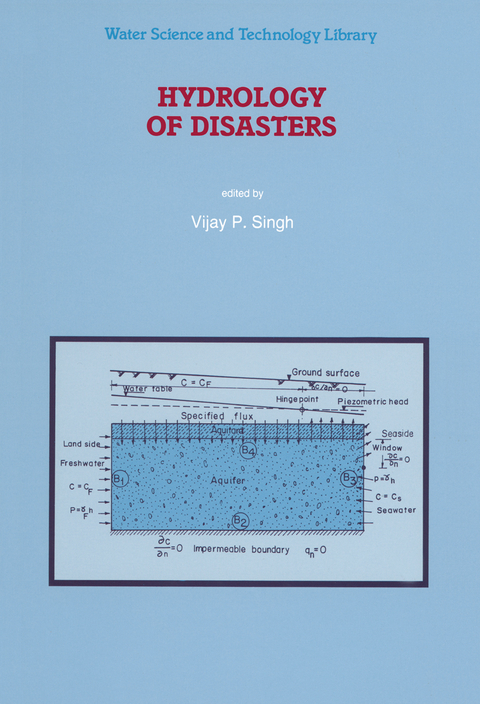
Hydrology of Disasters
Springer (Verlag)
978-90-481-4715-1 (ISBN)
The General Assembly of the United Nations passed a resolution on December 11, 1987, designating the 1990s as the International Decade for Natural Disaster Reduction. This resolution has served as a catalyst in promotion of international cooperation in the field of natural disaster reduction; in initiation of wide-ranging research activities on natural and man-made disasters; in development of tech nologies for assessment, prediction, prevention, and mitigation through technical assistance, technology transfer, demonstration projects, and education and training; and in dissemination of information related to measures for assessment, prediction, prevention, and mitigation of natural disasters. Disasters are manifestations of environmental extremes. Depending upon the type of disasters, their occurrence may have short-term andlor long-term detri mental environmental consequences. Disasters cannot be prevented altogether, but their impact can be mitigated. This book is an attempt to provide a discussion of hydrological aspects of the various types of natural disasters. It is hoped that others will be stimulated to write more comprehensive texts on this subject of enormous importance.
1 Disasters: Natural or Man-made.- 1.1 Types of Disasters.- 1.2 Environmental and Hydrologic Consequences.- 1.3 Mitigation of Disasters.- 2 Representativity of Extreme Wind Data.- 2.1 Introduction.- 2.2 Wind phenomena Classified by the Wind Sspectrum.- 2.3 What Are Representative Wind Data?.- 2.4 Representativity of “Potential Wind”.- 2.5 Roughness Determination at Ordinary Wind Stations.- 2.6 Scale of Application of Station-Observed Wind.- 2.7 Getting and Using Potential Wind Data.- 2.8 Distribution of Average Wind Speeds.- 2.9 Shelter Problems in Analysis of Extreme Stormwind speeds.- 2.10 Some Available Studies of Extreme wind Speeds.- 3 Climate Change and Hydrological Disasters.- 3.1 Introduction.- 3.2 The Greenhouse Effect, Climate Change and Hydrological Regimes.- 3.3 Estimating the Impacts of Climate Change on Hydrological Characteristics.- 3.4 Impacts of Climate Change on Floods.- 3.5 Impact of Climate Change on Drought.- 3.6 Conclusions.- 4 Extreme Floods.- 4.1 Introduction.- 4.2 Limitations of Statistical Methods for Estimating Design Floods.- 4.3 Data Series Used in the Estimation of Design Floods.- 4.4 Flood “Quantiles” as Design Events.- 4.5 Statistical Hypotheses Used for Estimating Design Floods.- 4.6 Some Remarks Pertaining to Flood Data.- 4.7 Choice of “D / E Procedure” for Flood Frequency Analysis.- 4.8 Regional Flood Frequency Estimation.- 4.9 Conclusions.- 5 Dam-Breach Floods.- 5.1 Introduction.- 5.2 Breach Description.- 5.3 Dam-Breach Flood Routing.- 5.4 Dam-Breach Flood Routing Data.- 5.5 Teton Dam-Breach Flood Case Study.- 5.6 Uncertainties of Dam-Breach Flood Modeling.- 6 Extreme Droughts.- 6.1 Introduction.- 6.2 Physical Systems Involved in a Drought.- 6.3 The Evolution of Extreme Drought.- 6.4 Modeling an Extreme Drought.- 6.5Discussion and Conclusions.- 7 Mud and Debris Flows.- 7.1 Introduction.- 7.2 Physical Processes.- 7.3 Methods of Prediction: When, Where, and How Much.- 7.4 Debris Flow Mitigation.- 7.5 Statistical Modeling of Debris Flows.- 7.6 Conclusions.- 8 Landslides.- 8.1 Introduction.- 8.2 Hydrological Triggering Mechanisms.- 8.3 Rainfall and Landslide Disasters.- 8.4 Regional Groundwater Flow.- 8.5 First-time and reactivated landslides.- 8.6 First-time Translational Slides.- 8.7 First-Time Rotational and Complex Deep-Seated Pre-Existing Landslide Movements.- 8.8 Landslide Caprocks and Their Response to Rainfall.- 8.9 Groundwater Models, Pre-Existing Landslide Complexes and Regional Planning.- 8.10 Landslides Associated with Snowmelt, Permafrost and Glaciers.- 8.11 Erosion, Rivers and Landslides.- 8.12 Storm-Induced Submarine Landslides.- 8.13 Conclusions.- 9 Land Subsidence.- 9.1 Introduction.- 9.2 Review of Mathematical Theory of Land Subsidence due to Fluid Withdrawal.- 9.3 Illustrative Case Studies.- 10 Saltwater Intrusion.- 10.1 Hydrological Aspects.- 10.2 Sharp Interface and Density Dependent Approaches.- 10.3 Dispersion in Porous Media.- 10.4 Mechanism of Saltwater Intrusion into Coastal Aquifers.- 10.5 Governing Equations.- 10.6 Initial and Boundary Conditions.- 10.7 Numerical Methods.- 10.8 Finite Element Formulation for Density Dependent Problems.- 10.9 Study Cases.- 10.10Concluding Remarks.- 11 Avalanche Dynamics.- 11.1 Introduction.- 11.2 Some Distinctive Characteristics of Granular Flows.- 11.3 One-Dimensional Model.- 11.4 Two-Dimensional Unconfined Flow.- 11.5 Density and Turbidity Current Concept.- 11.6 Two-phase Flow Models.- 11.7 Concluding remarks.- 12 Hydrological Disasters Associated with Volcanoes.- 12.1 Introduction.- 12.2 Steam (Phreatic) Explosions.- 12.3Eruptions Through a Crater Lake.- 12.4 Pyroclastic Flows Interacting with Water.- 12.5 Volcanic Melting of Snow and Ice.- 12.6 Volcanogenic Tsunamis.- 12.7 Release of Gases from a Crater Lake.- 12.8 Non-Volcanic Initiated Collapse of a Crater Lake.- 12.9 Heavy Rains on Recently Erupted Materials.- 12.10Conclusion.- 13 Earthquakes.- 13.1 Introduction.- 13.2 Example of Hydrologic Consequences of Earthquakes.- List of Contributors.
| Erscheint lt. Verlag | 15.12.2010 |
|---|---|
| Reihe/Serie | Water Science and Technology Library ; 24 |
| Zusatzinfo | XIV, 442 p. |
| Verlagsort | Dordrecht |
| Sprache | englisch |
| Maße | 155 x 235 mm |
| Themenwelt | Naturwissenschaften ► Biologie ► Ökologie / Naturschutz |
| Naturwissenschaften ► Geowissenschaften ► Geologie | |
| Naturwissenschaften ► Geowissenschaften ► Hydrologie / Ozeanografie | |
| Naturwissenschaften ► Geowissenschaften ► Meteorologie / Klimatologie | |
| ISBN-10 | 90-481-4715-8 / 9048147158 |
| ISBN-13 | 978-90-481-4715-1 / 9789048147151 |
| Zustand | Neuware |
| Informationen gemäß Produktsicherheitsverordnung (GPSR) | |
| Haben Sie eine Frage zum Produkt? |
aus dem Bereich


